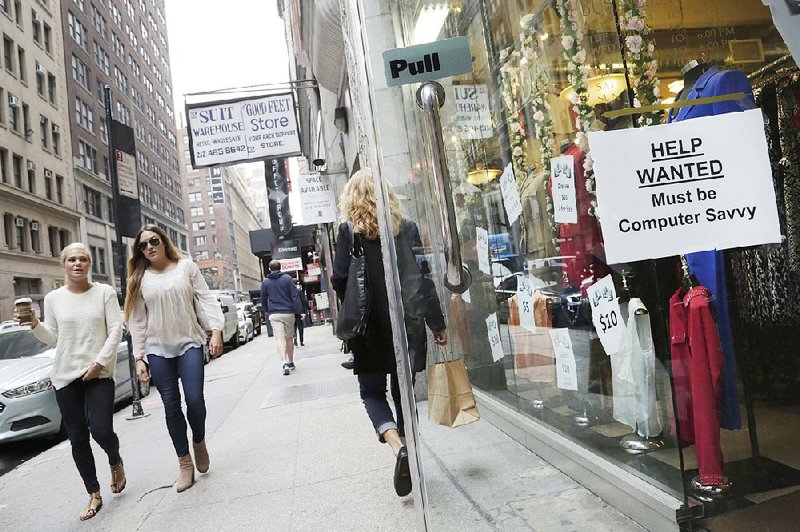WASHINGTON -- The U.S. economy grew at a slightly faster rate in the summer than previously reported, mainly because businesses restocked their goods at a stronger pace than first thought.
The overall economy, as measured by the gross domestic product, grew at an annual rate of 2.1 percent in the July-September period, the Commerce Department reported Tuesday. It previously estimated growth of 1.5 percent.
"You're getting more growth in the third quarter, and perhaps that could come at the expense of less growth in the next couple of quarters," said Jim O'Sullivan, chief U.S. economist at High Frequency Economics Ltd. in Valhalla, N.Y. Still, the backdrop for consumer spending remains positive, he said, as "the labor market is continuing to improve, which augurs well for wage income to accelerate."
A second report Tuesday showed consumer confidence unexpectedly declined in November to the lowest level in more than a year as Americans grew less enthusiastic about the labor-market outlook.
Even with Tuesday's revision of GDP, economic growth slowed sharply from a 3.9 percent gain in the second quarter. The economy then was rebounding from a harsh winter that had sapped first-quarter growth to a 0.6 percent pace.
The latest numbers, however, should give the Federal Reserve confidence as it considers an interest-rate increase at its next meeting in December, analysts said.
A healthy labor market and falling gasoline prices are expected to fuel consumer spending, pushing GDP growth in the current quarter to 2.5 percent or better, economists forecast.
"Domestic demand in the U.S. economy remains very solid, something that will surely give comfort to the Fed as it ponders its next move," said Robert Kavcic, senior economist at BMO Capital Markets.
A slowdown in stockpiling trimmed economic growth by 0.6 percentage point in the third quarter. But that was an improvement from the government's first estimate a month ago that reduced inventory stockpiling had cut growth by 1.4 percentage points. The government will make one final estimate of third-quarter GDP next month.
While the revision in inventories helped third-quarter growth, this improvement was offset somewhat by slightly slower growth in consumer spending, which grew at a 3 percent annual rate in the summer. The revision reflected in part weaker spending on cellphones than initially estimated.
The trade deficit was a bigger drag than initially estimated, trimming growth by 0.2 percentage point, as exports grew by just 0.9 percent in the quarter, down from a 1.9 percent initial estimate. American exports have been held back this year by weakness overseas and a rising value of the dollar, which make U.S. goods less competitive on foreign markets.
While overall GDP growth is expected to accelerate slightly to around 2.5 percent for the year, economists are forecasting that 2015 will be another year of only modest economic growth.
The expectation of stronger consumer spending in the fourth quarter reflects the solid job gains year. The government reported that employers created 271,000 jobs in October, and the unemployment rate fell to a seven-year low of 5 percent.
That strong jobs performance has raised expectations that the Fed will raise interest rates at its next meeting Dec. 15-16. It has kept its benchmark rate at a record low near zero for seven years.
Confidence in the economy eroded this month as Americans became more worried about the job market.
The Conference Board's consumer confidence index slumped to 90.4, the lowest since September 2014, from a revised October reading of 99.1, the New York-based private research group said Tuesday. The November gauge was weaker than the lowest forecast in a Bloomberg survey of economists. The cutoff date of the Conference Board's survey was Nov. 12.
The share of Americans who see greater job availability in the next six months fell to the lowest level since October 2011, and more expect their incomes to decline. While consumers were less upbeat about the labor market, the report showed buying plans held up and suggested steady spending as the Christmas shopping season begins.
"Heading into 2016, consumers are cautious about the labor market and expect little change in business conditions," Lynn Franco, director of economic indicators at the Conference Board, said in a statement.
The median forecast called for the gauge to rise to 99.5 in November, according to the Bloomberg survey of 70 economists. Estimates ranged from 96 to 103.5. In January, the index reached an almost eight-year high of 103.8.
The drop was broad-based, with confidence declining among all age groups, particularly among those younger than 35, and most income brackets. Sentiment slumped for Americans earning less than $15,000 a year.
The drop in consumer confidence was a curveball for many economists, some of whom warned that the population might be reflecting concerns about hiring momentum while others could not reconcile the survey with other indicators hinting at a resilient U.S. economy.
"November's results could be sending a cautionary signal about the key economic variable of job growth," said Joshua Shapiro, chief U.S. economist at the consultancy MFR.
Information for this article was contributed by Martin Crutsinger and Josh Boak of The Associated Press and by Ali Donaldson and Victoria Stilwell of Bloomberg News.
Business on 11/25/2015
